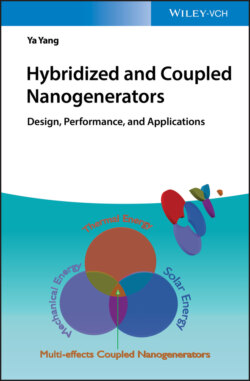Читать книгу Hybridized and Coupled Nanogenerators - Ya Yang - Страница 41
2.3.4.2 Wind Gauging System
ОглавлениеA wind vector sensor system, which can detect wind speed and direction, has been widely used in weather forecasting. Traditionally, wind sensors need external power sources or conventional batteries, which limit their long‐term work. Wang et al. developed a self‐powered wind sensor system based on an anemometer TENG and a wind vane TENG. This system can simultaneously detect wind speed and direction [40]. Yang et al. developed a self‐powered wind vector sensor system based on four TENGs [32]. To detect wind flows from multiple directions, four independent wind‐driven TENGs were fixed along four directions, as shown in Figure 2.15a. Figure 2.15b shows the external circuit diagram. The output current signals of the wind‐driven TENGs could be enhanced by increasing the wind speeds. Thus, by measuring the current signals, the wind speeds could be in turn calculated, as shown in Figure 2.15c. The output voltage peaks have small fluctuations, which can be independently used to confirm the wind direction (Figure 2.15d). The output voltage signals were connected to 16 channels, forming a mapping figure. When no wind flowed along the four directions, the value of the output voltage was 0, and when the wind flowed along one direction, the wind direction can be confirmed by observing the mapping figures, as shown in Figure 2.15e–h.
